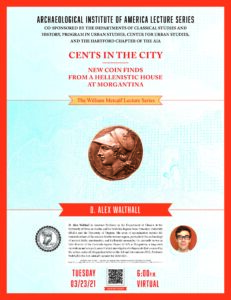D. Alex Walthall
March 23, 2021 @ 6:00 pm
Cents in the City: New Coin Finds from a Hellenistic House at Morgantina (Sicily)
Alex Walthall, University of Texas at Austin

The ancient city of Morgantina, located in eastern Sicily, has long held an important place at the intersection of archaeology and numismatics.
Between 2014 and 2019, archaeologists working with the American Excavations of Morgantina: Contrada Agnese Project (AEM: CAP) unearthed the remains of a modestly-appointed house built and occupied during the city’s Hellenistic heyday. In antiquity, the house belonged to a bustling, mixed-used neighborhood, located at the western edge of the ancient urban center. The occupants of the house appear to have engaged in a variety of industrial activities, including the milling of grain and, possibly, the baking of bread, judging from the presence of two large rotary millstones and an oven inside the building. That money clearly exchanged hands at the house is evidenced by the purpose-built shop on the property, which opened directly onto one of the city’s main avenues. Among the many thousands of objects recovered in the course of the CAP excavations, more than 400 bronze and silver coins of Greek, Roman, and Punic mints were found within the house. From small change accidentally lost through casual exchange to coin hoards secreted away against walls and under floors, the coin finds from the House of the Two Mills offer an extraordinary glimpse into the role that coinage played in the daily lives of the ancient Morgantinoi.
I begin this talk with a brief overview of the AEM:CAP excavations and address how these recent investigations have advanced our appreciation for the dynamic character of domestic space in the ancient city. I next provide a summary of the numismatic finds from the House of the Two Mills, highlighting instances in which this new material contributes fresh perspectives on long-standing numismatic conversations. I go on to compare the numismatic assemblage from the House of the Two Mills with those from other buildings in the same quarter of the city as well as with the assemblages recovered from other houses at Morgantina. In doing so, I consider what these coins may reveal about wider patterns of monetary circulation on the island during the 3rd century BCE, a time of great political and economic upheaval for the cities of eastern Sicily. Finally, I address how the methods of digital and geospatial recording adopted by the CAP excavations have allowed for a more nuanced approach to interpreting coins in the archaeological record, and use this as an opportunity to suggest possible avenues for future collaboration between archaeologists and numismatists.
